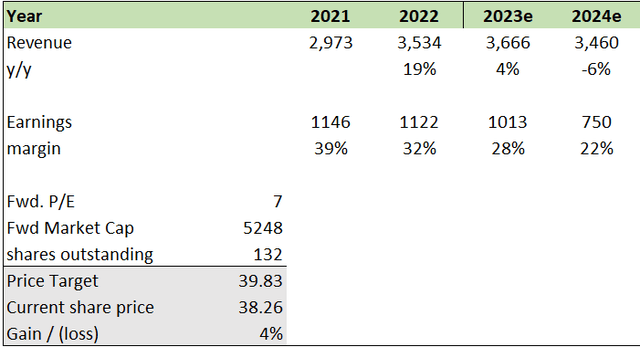Investment action
Based on my current outlook and analysis of Comerica Incorporated (NYSE:CMA), I recommend a hold rating. The bank’s most recent quarter financial results reveal a decline in net income compared to the preceding quarter. During the quarter, CMA’s strategic choice to exit from the Mortgage Banker Finance sector played a pivotal role in the average balance decrease. This decision, in tandem with a decline in equity fund services, accentuates the challenges and hurdles CMA is confronting. On the top of these challenges, there was an increase in criticized assets within CMA’s credit portfolio.
Basic Information
CMA Incorporated operates through three primary business segments: the Commercial Bank, which caters to businesses offering various financial services; the Retail Bank, serving individual customers with a range of banking products; and the Wealth Management segment, providing financial services and products, including annuities and insurance, to both institutions and individuals. Additionally, CMA has a Finance Division responsible for managing the corporation’s funding, liquidity, and capital needs, as well as handling interest sensitivity analysis and strategies to mitigate exposure to various financial risks.
Review
CMA reported weaker financial results in the third quarter of 2023. The bank reported a net income of $251 million, which translates to a robust $1.84 per share. However, the previous quarter reported net income of $273 million or $2.01 per share. This represents a decline of approximately 8.05%. On the flip side, a key indicator of a bank’s financial health is its Common Equity Tier 1 [CET1] ratio. For CMA, this ratio stood at an impressive 10.79%. This is not just a number; it signifies the bank’s strong capital position, especially when considering that it surpasses its own target of 10%. Such a robust capital position is indicative of the bank’s resilience and its ability to withstand economic downturns. What’s even more noteworthy is that CMA achieved these financial milestones despite facing disruptive industry events earlier in the such as March 2023 collapse of Silicon Valley Bank which resulted in a bank run. This resilience underscores the bank’s strategic prowess, as it not only navigated through these challenges but also managed to exceed profitability expectations.
During the quarter, CMA made some pivotal changes to its balance sheet. I noticed that their average loans and commitments saw a decline with average loans declining to $54 billion. This is a stark contrast to previous quarter whereby it grew to $55.4 billion. One major move that caught my attention was their plan to step away from the Mortgage Banker Finance sector. This step alone accounted for nearly half of the drop in their average balances. They aim to wrap up this transition by year’s end. Additionally, there was a marked decrease in their equity fund services, especially among clients with whom they don’t have a close relationship. Yet, CMA seems to still value this area, highlighting its significance in its overall business approach. Looking ahead, CMA has set its sights high. They’re aiming for a 7% growth in their average loans for 2023. If they pull this off, it’ll be their best performance in this area in ten years. This goal reflects their faith in their lending prowess, even as they navigate through these strategic shifts. However, I believe that the decision to exit the Mortgage Banker Finance sector is expected to continue impacting their balances in the fourth quarter.
CMA’s credit performance in the current quarter showcased its resilience and robust risk management strategies. The bank’s credit portfolio continued to exhibit strength, even as the financial landscape evolved. A notable point in their credit performance was the increase in criticized assets. While this might raise eyebrows at first glance, CMA had anticipated this trend as part of a broader normalization process. Diving deeper into the specifics, the majority of the increase in criticized assets was sourced from the commercial real estate book. This sector can be volatile, but CMA’s exposure here is characterized by its focus on construction financing. The bank has strategically partnered with strong borrowers and sponsors in this space, which significantly mitigates potential risks. As of the reporting period, CMA did not foresee significant loss content within this commercial real estate portfolio, further emphasizing their confidence in their credit decisions and risk management practices. In essence, while there were shifts in the credit landscape, CMA’s approach to credit and risk showcased a balance between strategic growth and prudent risk management.
Valuation
I anticipate that CMA will see a 4% growth in FY23, followed by a 6% decline in FY24. These projections align with the broader market consensus. The anticipated dip in growth is largely influenced by CMA’s comparatively weaker performance in the third quarter, especially when compared with the preceding quarter. This was evident in the decrease in net income, suggesting that macroeconomic challenges are exerting pressure on them. Furthermore, there was a noticeable decline in average loans, average balances, and commitments. This was primarily due to CMA’s strategic move to withdraw from the mortgage banker finance sector and a reduction in equity fund services. Collectively, these indicators suggest that CMA is navigating through challenges rather than capitalizing on opportunities. The decision to exit the mortgage banker finance sector, which is responsible for approximately 50% of the drop in average balances, is projected to conclude by the end of the year. As a result, I foresee this move impacting the latter half of 2023, with its full impact manifesting at the onset of FY24.

Author’s work
Currently, CMA trades at approximately 6x forward P/E, while its peers have a median of around 7x. Notably, CMA boasts a net margin of about 33%, which surpasses the industry median of 29%. Additionally, its projected next twelve months revenue growth rate is negative 32%, aligning closely with its peers’ median decline of 31%. Given these factors, I anticipate an upward revision in CMA’s forward P/E, aligning it closer to the peers’ median of 7x. My price target for CMA is approximately $39.8, which is nearly in line with its current trading price. However, considering the challenges CMA is grappling with, combined with the minimal margin of safety reflected in its present stock price, my recommendation for CMA would be a hold rating.

Author’s work
Risk and final thoughts
One upside risk would be the potential for outperformance in other sectors. While CMA has faced challenges, particularly with its decision to exit the Mortgage Banker Finance sector and the decline in equity fund services, it’s worth noting that the bank might be strategically positioning itself for future growth in other sectors. If CMA successfully capitalizes on new growth opportunities or strengthens its presence in more profitable niches, it could lead to better-than-expected financial performance. This potential for outperformance in such sectors could drive stock prices higher and challenge the current hold rating.
CMA’s recent quarterly results showed a decline in net income compared to the previous quarter. However, the bank’s CET1 ratio, an essential measure of financial health, remains strong, indicating its resilience even amidst industry disruptions like the collapse of the prominent Silicon Valley Bank. Strategically, CMA has decided to exit the Mortgage Banker Finance sector, which significantly impacted its average balances. This move, combined with a decrease in equity fund services, highlights the headwind and challenges the company is facing. Furthermore, there’s been a rise in criticized assets within CMA’s credit portfolio, which raises some concerns. However, the management has expressed confidence in managing this situation. Considering CMA’s most recent quarter performance, coupled with the prevailing economic challenges, my recommendation for CMA remains a ‘hold’ rating.
Read the full article here



